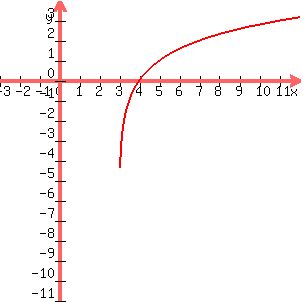Question 71811: Find the domain and range of the graph of each function. y=log2(x-3)
(2 is the base of the log) WE were told that the answer would involve inf. -inf or xero
Found 2 solutions by stanbon, Edwin McCravy:
Answer by stanbon(75887)   (Show Source): (Show Source):
You can put this solution on YOUR website! Find the domain and range of the graph of each function. y=log2(x-3)
(2 is the base of the log)
-------------------
y=log2(x) has domain (0,inf) and range (-inf,inf)
But you have y=log2(x-3):
The x-3 moves the x values 3 to the right and leaves the y values as they were.
So, domain is (3,inf) and range is (-inf,inf).
=========
Cheers,
Stan H.
Answer by Edwin McCravy(20063)   (Show Source): (Show Source):
You can put this solution on YOUR website! Find the domain and range of the graph of each function.
y=log2(x-3). WE were told that the answer would involve
inf. -inf or zero
Only logarithms of positive numbers are defined. Therefore log2(x-3)
is only defined when x-3 is positive, or
x - 3 > 0
x > 3
So the domain is (3, ¥)
Plot the graph by y = log2(x-3) getting some points, say
(4,0), (5,1), (7,2), (11,3) (3.25, -2)
 The vertical line (drawn in green below) has equation x = 3
and it is an asymptote:
The vertical line (drawn in green below) has equation x = 3
and it is an asymptote:
 So the range (the set of possible y-values) contains all real
values and is thus (-¥, ¥)
Edwin
So the range (the set of possible y-values) contains all real
values and is thus (-¥, ¥)
Edwin
|
|
|